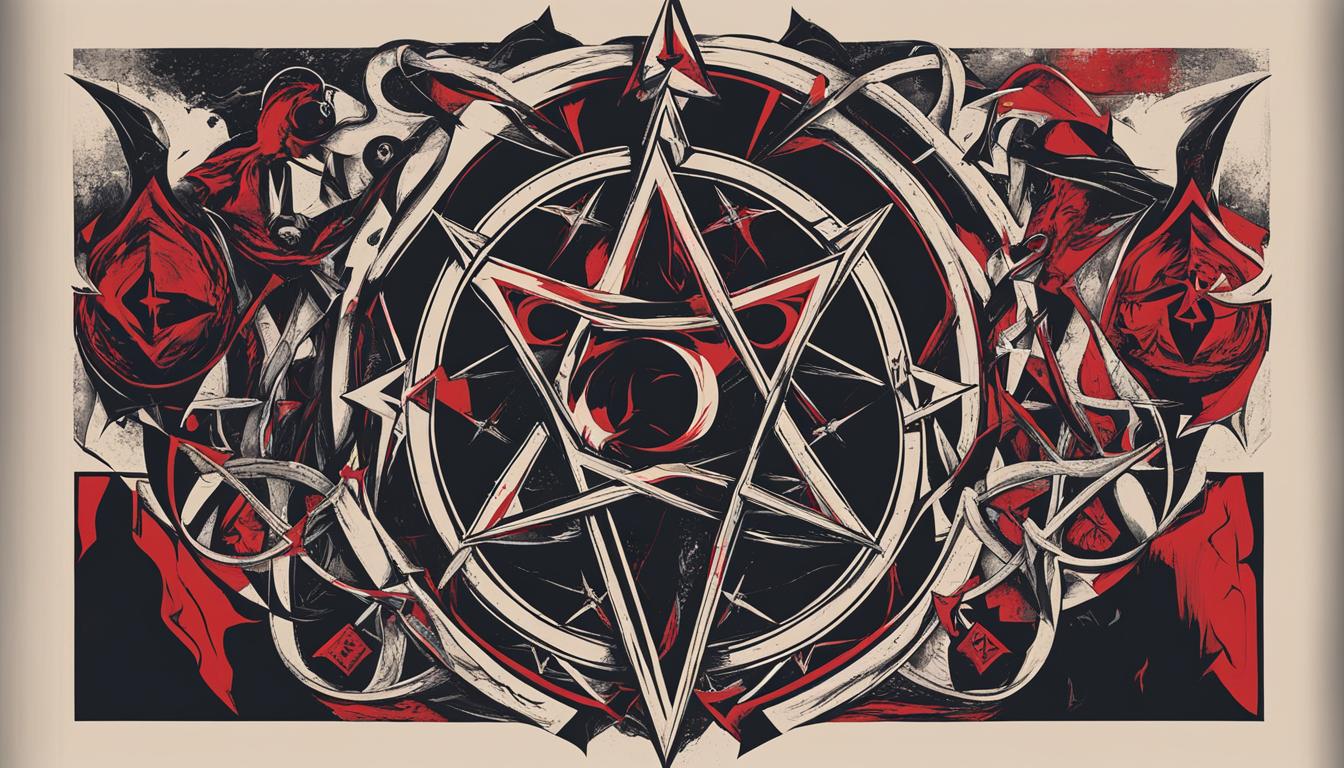In this article, we will explore the key differences between the Satanic Bible and the Atheist Manifesto, two ideological texts that delve into contrasting belief systems. While the Satanic Bible focuses on Satanism and the symbolism of Satan, the Atheist Manifesto advocates for atheism and the rejection of religious beliefs.
The Satanic Bible analyzes the principles and practices of Satanism, emphasizing individual autonomy and self-determination. On the other hand, the Atheist Manifesto offers a review of atheism, promoting scientific reasoning and critical thinking in the absence of belief in gods or deities. Understanding the nuances between these texts can provide valuable insights into different philosophies and perspectives.
Key Takeaways:
- The Satanic Bible focuses on Satanism and the symbolism of Satan, while the Atheist Manifesto advocates for atheism and the rejection of religious beliefs.
- The Satanic Bible promotes individual autonomy and self-determination, challenging traditional religious beliefs and societal norms.
- The Atheist Manifesto emphasizes scientific reasoning, critical thinking, and the rejection of belief in gods or deities.
- Both texts challenge traditional religious beliefs but offer divergent ideologies and philosophical frameworks.
- Understanding the differences between these texts provides insights into the diversity of human beliefs and philosophies.
Origins of the Satanic Bible
The Satanic Bible, a controversial and influential text, was written by Anton LaVey and published in 1969. LaVey, a charismatic figure, founded the Church of Satan and is considered a key figure in modern Satanism. His book combines elements of black magic, occult concepts, secular philosophy, rationalism, and anti-Christian ridicule. It challenges traditional religious beliefs and societal norms, promoting individual autonomy and self-determination.
Anton LaVey was born Howard Stanton Levey in 1930 in Chicago. He developed an interest in the occult and esoteric from a young age and later became a carnival musician and a psychic investigator. In 1966, LaVey founded the Church of Satan, which served as a platform for his philosophical and ideological beliefs. The Satanic Bible, his most famous work, became the central text of the Church and solidified LaVey’s position as a prominent figure in the Satanic movement.
| Year | Event |
|---|---|
| 1930 | Anton LaVey is born in Chicago |
| 1966 | LaVey founds the Church of Satan |
| 1969 | The Satanic Bible is published |
The Satanic Bible sparked controversy upon its release and continues to be a subject of fascination and debate. While some view it as a genuine religious text, others see it as a provocative work intended to challenge societal norms and religious dogma. Regardless of one’s perspective, the origins of the Satanic Bible and the Church of Satan remain significant in understanding the development and influence of modern Satanism.
Key Principles of the Satanic Bible
The Satanic Bible, written by Anton LaVey and published in 1969, is a philosophical and ideological text that explores the principles of Satanism. It consists of four books: The Book of Satan, The Book of Lucifer, The Book of Belial, and The Book of Leviathan. These books delve into various aspects of Satanic philosophy, including indulgence, love, hate, sex, rituals, and magic.
One of the key principles of the Satanic Bible is the rejection of an external God or deity. Instead, it encourages individuals to embrace their own nature and instincts, promoting the pursuit of personal happiness and fulfillment. The Satanic Bible also emphasizes the importance of individual autonomy and self-determination, urging people to think for themselves and question societal norms and religious dogma.
Another significant aspect of the Satanic Bible is the incorporation of Satanic rituals. These rituals serve as a means of self-expression, personal empowerment, and psychological transformation. Through ritual practices, individuals can tap into their own potential and harness their desires and emotions. These rituals often involve symbolism, invocations, and declarations of intent to manifest one’s desires in the world.
Satanic Philosophy in Practice
To further understand the Satanic philosophy, let’s take a closer look at some of the key principles and practices outlined in the Satanic Bible:
- Indulgence: The Satanic Bible encourages individuals to indulge in their desires and pursue what brings them pleasure, as long as it does not infringe upon the rights of others.
- Rational Self-Interest: Satanic philosophy promotes rational self-interest, advocating for individuals to prioritize their own well-being and pursue what benefits them personally.
- Individualism: The Satanic Bible emphasizes the importance of individualism, urging people to embrace their uniqueness and reject conformity to societal norms or religious expectations.

| Key Principles of the Satanic Bible | Satanic Philosophy | Satanic Rituals |
|---|---|---|
| Rejection of an external God or deity | Embrace personal nature and instincts | Serve as a means of self-expression |
| Importance of individual autonomy | Encourage pursuit of personal happiness | Facilitate personal empowerment |
| Emphasis on questioning societal norms and religious dogma | Explore individual desires and emotions | Incorporate symbolism and invocations |
Origins of the Atheist Manifesto
The Atheist Manifesto traces its origins back to the emergence of atheism as a philosophical concept. While atheistic beliefs have existed throughout history, the modern Atheist Manifesto emerged as a response to the influence of religion in society. It gained prominence during the Enlightenment period when thinkers began to question traditional religious dogma and advocate for reason and empirical evidence.
The history of the Atheist Manifesto can be seen in the works of prominent atheist philosophers such as Friedrich Nietzsche, Bertrand Russell, and Richard Dawkins. These thinkers played a crucial role in challenging the existence of God and advocating for a worldview based on scientific inquiry and critical thinking. Their writings laid the foundation for the modern atheistic movement and provided a platform for atheists to express their rejection of religious beliefs.
Today, the Atheist Manifesto continues to evolve as atheism gains traction and visibility in society. It serves as a rallying point for atheists around the world, encouraging them to question religious authority, promote secularism, and advocate for a society based on reason and evidence.
Core Principles of the Atheist Manifesto
The Atheist Manifesto is rooted in core principles that shape the foundation of atheistic beliefs and the rejection of religious dogma. These principles revolve around reason, evidence, and scientific inquiry as guiding forces in understanding the natural world and human existence. Atheists who adhere to the Atheist Manifesto prioritize critical thinking and rationality, advocating for a secular society that separates religious beliefs from governance and public policy.
At the heart of the Atheist Manifesto is the belief that there is no supernatural power or higher being governing the universe. Atheists reject the notion of a personal deity and instead embrace the idea that humans have the capacity to understand and shape their own lives through reason and empirical evidence. This rejection of religious dogma challenges traditional notions of divine authority and places a strong emphasis on individual autonomy and personal freedom.
The Atheist Manifesto also promotes ethical principles that are grounded in compassion, empathy, and social justice. Atheists who follow this manifesto prioritize the well-being of individuals and strive for a society that values fairness, equality, and human rights. By emphasizing the importance of empathy and compassion, the Atheist Manifesto seeks to create a moral framework that is independent of religious teachings and based on humanistic values.
Key Principles of the Atheist Manifesto
| Principle | Description |
|---|---|
| 1. Reason and Evidence | Atheists rely on reason and evidence to understand the world, rejecting supernatural explanations and embracing scientific inquiry. |
| 2. Secularism | Atheists advocate for the separation of religion and government, promoting a society that is free from religious influence in public affairs. |
| 3. Humanism | Atheists prioritize the well-being and rights of individuals, promoting a moral framework based on compassion, empathy, and social justice. |
| 4. Autonomy | Individual autonomy is highly valued in the Atheist Manifesto, empowering individuals to think for themselves and make informed decisions. |
The core principles of the Atheist Manifesto provide a philosophical framework that challenges traditional religious beliefs and offers an alternative worldview based on reason, evidence, and humanistic values. By rejecting religious dogma and embracing critical thinking, atheists who follow the Atheist Manifesto seek to create a society that promotes intellectual freedom, equality, and personal fulfillment.
Similarities between the Satanic Bible and Atheist Manifesto
While the Satanic Bible and the Atheist Manifesto may seem vastly different at first glance, there are some surprising commonalities between the two texts. Both explore alternative belief systems and challenge traditional religious ideologies, advocating for individuals to think critically and embrace personal autonomy.
The Pursuit of Personal Happiness
One significant similarity between the Satanic Bible and the Atheist Manifesto is their shared emphasis on the pursuit of personal happiness. Both texts reject the notion of self-denial and encourage individuals to live fulfilling lives based on their own desires and values. By promoting the importance of personal happiness, these texts highlight the significance of individual autonomy and the rejection of societal expectations.
Questioning Religious Authority
Another commonality between the Satanic Bible and the Atheist Manifesto is their mutual challenge of religious authority. Both texts reject traditional religious beliefs and norms, urging individuals to question and critically analyze religious doctrines. By advocating for skepticism and independent thinking, these texts empower individuals to form their own beliefs based on rationality and evidence.
Promotion of Critical Thinking
Lastly, the Satanic Bible and the Atheist Manifesto align in their promotion of critical thinking. Both texts encourage individuals to question societal norms, religious dogma, and cultural traditions. By emphasizing the importance of reason and evidence, these texts urge readers to engage in intellectual inquiry and challenge prevailing beliefs. This shared focus on critical thinking underscores the rational and thought-provoking nature of both texts.
| Satanic Bible | Atheist Manifesto |
|---|---|
| Embraces individual autonomy | Advocates for personal autonomy |
| Challenges traditional religious beliefs | Rejects the existence of gods |
| Promotes pursuit of personal happiness | Emphasizes fulfillment through personal values |
| Incorporates elements of ritual and magic | Favors scientific reasoning and evidence |
| Encourages critical thinking and rationality | Advocates for skepticism and independent thinking |
Contrasting the Satanic Bible and Atheist Manifesto
When examining the Satanic Bible and the Atheist Manifesto, it becomes clear that these two ideological texts diverge significantly in their underlying philosophies and core principles. While both challenge traditional religious beliefs, their approaches and perspectives vary greatly.
Key Differences:
1. Symbols and Beliefs: The Satanic Bible embraces the symbolism of Satan and incorporates elements of black magic and occult concepts. In contrast, the Atheist Manifesto rejects the existence of gods entirely and promotes atheism as a rejection of religious beliefs.
2. Practices and Rituals: The Satanic Bible includes instructions for Satanic rituals and magic, encouraging individuals to explore their own desires and embrace indulgence. On the other hand, the Atheist Manifesto prioritizes scientific inquiry, reason, and critical thinking as the basis for understanding the world.
3. Philosophical Frameworks: The Satanic Bible promotes individual autonomy, self-determination, and the pursuit of personal happiness and fulfillment. It challenges societal norms and traditional religious dogma. Conversely, the Atheist Manifesto emphasizes secularism, humanism, and ethical principles based on compassion, empathy, and social justice.
These differences in ideologies create distinct frameworks that separate the Satanic Bible from the Atheist Manifesto. While both texts share a common goal of challenging religious beliefs, they take divergent paths in their approach, beliefs, and practices.
| Satanic Bible | Atheist Manifesto | |
|---|---|---|
| Symbolism | Embraces symbolism of Satan | Rejects the existence of gods |
| Practices | Includes rituals and magic | Prioritizes scientific inquiry and reason |
| Philosophical Framework | Promotes individual autonomy and self-determination | Emphasizes secularism and humanism |
Understanding the differences between the Satanic Bible and the Atheist Manifesto provides insights into the diversity of human beliefs and philosophies. While they may both challenge traditional religious beliefs, their contrasting ideologies offer individuals different paths to navigate their understanding of spirituality and the human experience.
Conclusion
In conclusion, the Satanic Bible and the Atheist Manifesto offer distinct and contrasting perspectives on religion, belief systems, and the human experience. While both texts challenge traditional religious beliefs, they do so in different ways. The Satanic Bible embraces Satanic symbolism, promotes individual autonomy, and incorporates elements of magic and rituals. On the other hand, the Atheist Manifesto rejects the existence of gods entirely, emphasizes scientific reasoning, and encourages critical thinking.
These differences in philosophy and approach highlight the diversity of human beliefs and philosophies. The Satanic Bible focuses on personal empowerment and the pursuit of individual happiness, while the Atheist Manifesto prioritizes reason, evidence, and secular humanism. Understanding these differences can provide valuable insights into the complexities of human thought and the range of perspectives on religion and the meaning of life.
Whether one aligns more with the Satanic Bible or the Atheist Manifesto, both texts contribute to the ongoing dialogue surrounding religion, spirituality, and the nature of existence. They offer individuals alternative paths to explore and challenge the status quo, sparking conversations and encouraging individuals to think critically about their beliefs and values.
FAQ
What is the difference between the Satanic Bible and the Atheist Manifesto?
The Satanic Bible focuses on Satanism and the symbolism of Satan, while the Atheist Manifesto advocates for atheism and the rejection of religious beliefs.
Who wrote the Satanic Bible?
The Satanic Bible was written by Anton LaVey, the founder of the Church of Satan.
What are the key principles of the Satanic Bible?
The Satanic Bible promotes individual autonomy, the pursuit of personal happiness, and the rejection of traditional religious beliefs and societal norms.
What is the Atheist Manifesto?
The Atheist Manifesto is a philosophical text that advocates for atheism, the rejection of belief in gods or deities.
What are the core principles of the Atheist Manifesto?
The Atheist Manifesto promotes scientific reasoning, critical thinking, and the rejection of religious dogma.
What are the similarities between the Satanic Bible and the Atheist Manifesto?
Both texts challenge traditional religious beliefs, advocate for individual autonomy, and prioritize critical thinking and rationality.
How do the Satanic Bible and the Atheist Manifesto differ?
The Satanic Bible embraces Satanic symbolism and promotes indulgence, while the Atheist Manifesto rejects the existence of gods and emphasizes scientific reasoning.
 Skip to main content
Skip to main content


